100% Renewable Energy Supply for Brazil—The Role of Sector Coupling and Regional Development
Abstract
:1. Introduction
2. Materials and Methods
2.1. Optimization Model REMix
2.2. Data and Assumptions
2.3. Scenarios
3. Results
4. Discussion and Conclusions
Supplementary Materials
Acknowledgments
Author Contributions
Conflicts of Interest
Appendix A. Demand Response Model
| Symbol | Unit | Variable/Parameter |
|---|---|---|
| Coperation | k€/year | Operation and maintenance costs |
| PaddedCap (t) | GW | Installed electric capacity of additionally DR consumers |
| PbalInc (t) | GW | Balancing of earlier load increase |
| PbalRed (t) | GW | Balancing of earlier load reduction |
| Pinc (t) | GW | Demand response load increase |
| Pred (t) | GW | Demand response load reduction |
| WlevelInc (t) | GWh | Amount of increased and not yet balanced energy |
| WlevelRed (t) | GWh | Amount of reduced and not yet balanced energy |
| Δt | h | Calculation time interval |
| η1 | % | Efficiency describing additional demand caused by DR, independent of shifting time |
| η2 | %/h | Efficiency describing additional demand caused by DR, dependent of shifting time |
| cOMFix | %/year | Operation and maintenance fix costs |
| cOMVar1 | k€/MW | Operation and maintenance variable costs, independent of shifting time |
| cOMVar2 | k€/MWh | Operation and maintenance variable costs, dependent of shifting time |
| cspecInv | k€/MW | Specific investment cost |
| sflex (t) | % | Share of load reduction potential available in time step t |
| sfree (t) | % | Share of load increase potential available in time step t |
| PexistCap | GW | Already accessed capacity of DR loads |
| PmaxCap | GW | Maximum accessible capacity of DR loads |
Appendix B. Power Demand, Hydro Power, Biomass Power, and Grid Capacities
| Start (S) | End (E) | Techn. | S → E in MW | E → S in MW |
|---|---|---|---|---|
| XIN | IMP | AC | 4115 | 4115 |
| XIN | Norte 1 | AC | 2700 | 2700 |
| XIN | Norte 2 | AC | 2700 | 2700 |
| XIN | Belo Monte | AC | 11,000 | 11,000 |
| XIN | Sudeste | DC | 8000 | 8000 |
| IMP | Nordeste | AC | 8200 | 4849 |
| IMP | Norte 1 | AC | 8518 | 8518 |
| IMP | Centro-Oeste | AC | 5380 | 5598 |
| IV | Sudeste | AC | 6800 | 6800 |
| IV | Itaipu | AC | 6300 | 6300 |
| IV | Sul | AC | 2426 | 2317 |
| Sudeste | Nordeste | AC | 6500 | 6936 |
| Centro-Oeste | Norte 3 | DC | 7092 | 7092 |
| Centro-Oeste | Teles Pires | AC | 10,500 | 10,500 |
| Sudeste | Itaipu | DC | 5500 | 5500 |
| Sudeste | Sul | AC | 9420 | 9108 |
| Itaipu | Sul | AC | 2112 | 192 |
| Sudeste | Centro-Oeste | AC | 15,000 | 15,000 |
| Technology Region | Transport | Electric Heating | Hydrogen Electrolysis | Other |
|---|---|---|---|---|
| TWh/year | TWh/year | TWh/year | TWh/year | |
| Nordeste | 17.6 | 33.0 | 4.0 | 98.9 |
| Norte 1 | 1.9 | 10.2 | 1.2 | 35.3 |
| Norte 2 | 0.8 | 4.2 | 0.7 | 9.0 |
| Norte 3 | 0.5 | 3.1 | 0.7 | 4.5 |
| Centro-Oeste | 10.1 | 12.4 | 1.3 | 49.2 |
| Sudeste | 72.3 | 89.0 | 15.5 | 360.6 |
| Sul | 23.4 | 28.7 | 4.8 | 117.8 |
| Technology Region | Run-of-River Hydro S | Run-of-River Hydro M | Run-of-River Hydro L | Wave Power | ||||
|---|---|---|---|---|---|---|---|---|
| MW (el) | h/Year | MW (el) | h/Year | MW (el) | h/Year | MW (el) | h/Year | |
| Nordeste | 165 | 3256 | 0 | 6139 | 7895 | 4270 | 888 | 2628 |
| Norte 1 | 235 | 4799 | 243 | 5548 | 2440 | 5156 | 1089 | 2628 |
| Norte 2 | 0 | 4799 | 810 | 4880 | 1070 | 4596 | 0 | 0 |
| Belo Monte | 0 | 0 | 233 | 5790 | 11,000 | 4446 | 0 | 0 |
| Norte 3 | 165 | 4799 | 74 | 5264 | 4308 | 6061 | 0 | 0 |
| Teles Pires | 0 | 0 | 0 | 0 | 1820 | 4410 | 0 | 0 |
| Centro-Oeste | 1752 | 4611 | 1729 | 5320 | 8710 | 4620 | 0 | 0 |
| Sudeste | 1869 | 4611 | 2340 | 5033 | 1044 | 6146 | 1211 | 2628 |
| Itaipu | 0 | 0 | 0 | 0 | 8800 | 6148 | 0 | 0 |
| Sul | 1663 | 4779 | 1584 | 5214 | 5473 | 4977 | 1412 | 2628 |
| Technology Region | Reservoir Hydro S | Reservoir Hydro M | Reservoir Hydro L | Biomass CHP | Fuel Cells | |||
|---|---|---|---|---|---|---|---|---|
| MW (el) | h/Year | MW (el) | h/Year | MW (el) | h/Year | MW (el) | MW (el) | |
| Nordeste | 0 | 0 | 397 | 4292 | 2550 | 4292 | 2743 | 113 |
| Norte 1 | 0 | 0 | 0 | 0 | 1727 | 5519 | 809 | 33 |
| Norte 2 | 30 | 6745 | 250 | 4030 | 8370 | 4993 | 503 | 21 |
| Norte 3 | 0 | 0 | 217 | 3854 | 0 | 6044 | 503 | 21 |
| Centro-Oeste | 28 | 2803 | 1550 | 4292 | 18,368 | 4468 | 902 | 37 |
| Sudeste | 0 | 0 | 1526 | 4292 | 399 | 6132 | 10,627 | 438 |
| Sul | 0 | 0 | 795 | 4468 | 7437 | 4993 | 3260 | 134 |
| Technology Region | Run-of-River S | Run-of-River M | Run-of-River L | Reservoir S | Reservoir M | Reservoir L |
|---|---|---|---|---|---|---|
| MW (el) | MW (el) | MW (el) | MW (el) | MW (el) | MW (el) | |
| Nordeste | 45 | 593 | 0 | 0 | 483 | 0 |
| Norte 1 | 0 | 0 | 14,953 | 0 | 95 | 16,418 |
| Norte 2 | 9 | 0 | 708 | 0 | 0 | 0 |
| Norte 3 | 84 | 350 | 0 | 0 | 0 | 0 |
| Centro-Oeste | 481 | 764 | 1260 | 0 | 280 | 330 |
| Sudeste | 862 | 1499 | 0 | 0 | 3367 | 8063 |
| Itaipu | 0 | 0 | 0 | 0 | 608 | 0 |
| Sul | 997 | 158 | 2275 | 0 | 292 | 0 |
Appendix C. Evaluation of Wind and Solar Power Potentials in Brazil
| Region | Nordeste | Norte 1 | Norte 2 | Centro-Oeste | Sudeste | Sul | ||||||
|---|---|---|---|---|---|---|---|---|---|---|---|---|
| Parameter | Cap. | FLH | Cap. | FLH | Cap. | FLH | Cap. | FLH | Cap. | FLH | Cap. | FLH |
| Min. Wind Speed | GW (el) | h/Year | GW (el) | h/Year | GW (el) | h/Year | GW (el) | h/Year | GW (el) | h/Year | GW (el) | h/Year |
| = 4 km/h | 3246 | 1892 | 253 | 914 | 26 | 892 | 1410 | 953 | 1599 | 1009 | 396 | 1437 |
| = 5 km/h | 2122 | 2221 | 0 | 0 | 0 | 0 | 92 | 2086 | 420 | 1262 | 174 | 1888 |
| = 5.5 km/h | 1552 | 2357 | 0 | 0 | 0 | 0 | 44 | 2371 | 48 | 1639 | 79 | 2256 |
| = 6 km/h | 823 | 2568 | 0 | 0 | 0 | 0 | 0 | 0 | 1 | 2738 | 28 | 2852 |
| = 6.5 km/h | 225 | 2935 | 0 | 0 | 0 | 0 | 0 | 0 | 1 | 2776 | 27 | 2879 |
| = 7 km/h | 71 | 3384 | 0 | 0 | 0 | 0 | 0 | 0 | 0 | 0 | 8 | 3206 |
| Region | Nordeste | Norte 1 | Norte 2 | Sudeste | Sul | |||||
|---|---|---|---|---|---|---|---|---|---|---|
| Parameter | Cap. | FLH | Cap. | FLH | Cap. | FLH | Cap. | FLH | Cap. | FLH |
| Min. Wind Speed | GW (el) | h/Year | GW (el) | h/Year | GW (el) | h/Year | GW (el) | h/Year | GW (el) | h/Year |
| = 4 km/h | 417 | 2636 | 237 | 1942 | 56 | 1526 | 183 | 1446 | 200 | 2694 |
| = 5 km/h | 378 | 2810 | 160 | 2213 | 33 | 1929 | 89 | 1837 | 181 | 2866 |
| = 5.5 km/h | 330 | 2975 | 137 | 2282 | 32 | 1936 | 45 | 2289 | 172 | 2938 |
| = 6 km/h | 293 | 3107 | 133 | 2290 | 13 | 2155 | 16 | 2639 | 160 | 3003 |
| = 6.5 km/h | 222 | 3305 | 16 | 2757 | 0 | 0 | 13 | 2770 | 143 | 3083 |
| = 7 km/h | 128 | 3626 | 1 | 3367 | 0 | 0 | 0 | 0 | 82 | 3305 |
| = 7.5 km/h | 79 | 3922 | 1 | 3527 | 0 | 0 | 0 | 0 | 14 | 3468 |
Appendix D. Technology Parameter
| Technology | Installed Capacity | Average Reduction | Average Increase | Efficiency | Variable O & M Costs | Ref. |
|---|---|---|---|---|---|---|
| MW | MW | MW | % | €/MWh | ||
| Process industry shifting | 1601 | 603 | 286 | 99% | 50 | [53,54,55,57] |
| Process industry shedding | 3849 | 2210 | n.a. | 100% | 1000 | [53,54,55,57] |
| Cooling | 1666 | 500 | 600 | 95% | 10 | [56,57] |
References
- Ministério de Minas e Energia (MME). Balanço Energético Nacional 2015: Ano Base 2014; Ministério de Minas e Energia, Empresa de Pesquisa Energética (EPE): Brasilia, Brazil, 2015.
- International Energy Agency (IEA). World Energy Balances (2016 edition). In IEA Energy Statistics (Beyond 20/20); International Energy Agency: Paris, France, 2016. [Google Scholar]
- Schaeffer, R.; Szklo, A.; De Lucena, A.F.P.; Soria, R.; Chavez-Rodriguez, M. The vulnerable Amazon: The impact of climate change on the untapped potential of hydropower systems. IEEE Power Energy Mag. 2013, 11, 22–31. [Google Scholar] [CrossRef]
- De Lucena, A.F.P.; Szklo, A.S.; Schaeffer, R.; de Souza, R.R.; Borba, B.S.M.C.; da Costa, I.V.L.; Júnior, A.O.P.; da Cunha, S.H.F. The vulnerability of renewable energy to climate change in Brazil. Energy Policy 2009, 37, 879–889. [Google Scholar] [CrossRef]
- Corrêa da Silva, R.; de Marchi Neto, I.; Silva Seifert, S. Electricity supply security and the future role of renewable energy sources in Brazil. Renew. Sustain. Energy Rev. 2016, 59, 328–341. [Google Scholar] [CrossRef]
- Nass, L.L.; Pereira, P.A.A.; Ellis, D. Biofuels in Brazil: An Overview. Crop Sci. 2007, 47, 2228–2237. [Google Scholar] [CrossRef]
- La Rovere, E.L.; Pereira, A.S.; Simões, A.F. Biofuels and Sustainable Energy Development in Brazil. World Dev. 2011, 39, 1026–1036. [Google Scholar] [CrossRef]
- Raele, R.; Gama-Boaventura, J.M.; Fischmann, A.A.; Sarturi, G. Scenarios for the second generation ethanol in Brazil. Technol. Forecast. Soc. Chang. 2014, 87, 205–223. [Google Scholar] [CrossRef]
- De Paula Dias, M.A.; de Souza Vianna, J.N.; Felby, C. Sustainability in the prospective scenarios methods: A case study of scenarios for biodiesel industry in Brazil, for 2030. Futures 2016, 82, 1–14. [Google Scholar] [CrossRef]
- Portugal-Pereira, J.; Soria, R.; Rathmann, R.; Schaeffer, R.; Szklo, A. Agricultural and agro-industrial residues-to-energy: Techno-economic and environmental assessment in Brazil. Biomass Bioenergy 2015, 81, 521–533. [Google Scholar] [CrossRef]
- Aquila, G.; Rocha, L.C.S.; Junior, P.R.; Pamplona, E.D.O.; Queiroz, A.R.D.; Paiva, A.P.D. Wind power generation: An impact analysis of incentive strategies for cleaner energy provision in Brazil. J. Clean. Prod. 2016, 137, 1100–1108. [Google Scholar] [CrossRef]
- Pinto, J.T.M.; Amaral, K.J.; Janissek, P.R. Deployment of photovoltaics in Brazil: Scenarios, perspectives and policies for low-income housing. Sol. Energy 2016, 133, 73–84. [Google Scholar] [CrossRef]
- Pereira, A.O.; Cunha da Costa, R.; Costa, C.D.V.; Marreco, J.d.M.; La Rovere, E.L. Perspectives for the expansion of new renewable energy sources in Brazil. Renew. Sustain. Energy Rev. 2013, 23, 49–59. [Google Scholar] [CrossRef]
- Pereira, E.B.; Martins, F.R.; Abreu, S.D.; Rüther, R. Atlas Brasileiro de Energia Solar; Instituto Nacional de Pesquisas Espaciais (INPE): São José dos Campos, Brazil, 2006; Volume 1.
- De Souza Noel Simas Barbosa, L.; Orozco, J.F.; Bogdanov, D.; Vainikka, P.; Breyer, C. Hydropower and Power-to-gas Storage Options: The Brazilian Energy System Case. Energy Procedia 2016, 99, 89–107. [Google Scholar] [CrossRef]
- Viana, T.S.; Rüther, R.; Martins, F.R.; Pereira, E.B. Assessing the potential of concentrating solar photovoltaic generation in Brazil with satellite-derived direct normal irradiation. Sol. Energy 2011, 85, 486–495. [Google Scholar] [CrossRef]
- Centro de Pesquisas de Energia Elétrica (CEPEL). Atlas do Potencial Eólico Brasileiro; Centro de Pesquisas de Energia Elétrica: Rio de Janerio, Brazil, 2001. [Google Scholar]
- Chade Ricosti, J.F.; Sauer, I.L. An assessment of wind power prospects in the Brazilian hydrothermal system. Renew. Sustain. Energy Rev. 2013, 19, 742–753. [Google Scholar] [CrossRef]
- Schmidt, J.; Cancella, R.; Pereira, A.O. An optimal mix of solar PV, wind and hydro power for a low-carbon electricity supply in Brazil. Renew. Energy 2016, 85, 137–147. [Google Scholar] [CrossRef]
- Silva, A.R.; Pimenta, F.M.; Assireu, A.T.; Spyrides, M.H.C. Complementarity of Brazil׳s hydro and offshore wind power. Renew. Sustain. Energy Rev. 2016, 56, 413–427. [Google Scholar] [CrossRef]
- Saporta, L.A.D.C. O Papel Dos Reservatórios de Hidroelétricas na Integração da Geração Eólica no Sistema Interligado Nacional; Universidade Federal do Rio de Janeiro: Rio de Janeiro, Brazil, 2017. [Google Scholar]
- Lampreia, J.; de Araújo, M.S.M.; de Campos, C.P.; Freitas, M.A.V.; Rosa, L.P.; Solari, R.; Gesteira, C.; Ribas, R.; Silva, N.F. Analyses and perspectives for Brazilian low carbon technological development in the energy sector. Renew. Sustain. Energy Rev. 2011, 15, 3432–3444. [Google Scholar] [CrossRef]
- Andrade Guerra, J.B.S.O.D.; Dutra, L.; Schwinden, N.B.C.; Andrade, S.F.D. Future scenarios and trends in energy generation in brazil: supply and demand and mitigation forecasts. J. Clean. Prod. 2015, 103, 197–210. [Google Scholar] [CrossRef]
- Herreras Martínez, S.; Koberle, A.; Rochedo, P.; Schaeffer, R.; Lucena, A.; Szklo, A.; Ashina, S.; van Vuuren, D.P. Possible energy futures for Brazil and Latin America in conservative and stringent mitigation pathways up to 2050. Technol. Forecast. Soc. Chang. 2015, 98, 186–210. [Google Scholar] [CrossRef]
- Lucena, A.F.P.; Clarke, L.; Schaeffer, R.; Szklo, A.; Rochedo, P.R.R.; Nogueira, L.P.P.; Daenzer, K.; Gurgel, A.; Kitous, A.; Kober, T. Climate policy scenarios in Brazil: A multi-model comparison for energy. Energy Econ. 2016, 56, 564–574. [Google Scholar] [CrossRef]
- Nogueira de Oliveira, L.P.; Rodriguez Rochedo, P.R.; Portugal-Pereira, J.; Hoffmann, B.S.; Aragão, R.; Milani, R.; de Lucena, A.F.P.; Szklo, A.; Schaeffer, R. Critical technologies for sustainable energy development in Brazil: Technological foresight based on scenario modelling. J. Clean. Prod. 2016, 130, 12–24. [Google Scholar] [CrossRef]
- Miranda, R.; Soria, R.; Schaeffer, R.; Szklo, A.; Saporta, L. Contributions to the analysis of “Integrating large scale wind power into the electricity grid in the Northeast of Brazil”. Energy 2017, 118, 1198–1209. [Google Scholar] [CrossRef]
- De Faria, F.A.M.; Jaramillo, P. The future of power generation in Brazil: An analysis of alternatives to Amazonian hydropower development. Energy Sustain. Dev. 2017, 41, 24–35. [Google Scholar] [CrossRef]
- Lucena, A.; Szklo, A.; Schaeffer, R. Toward a Sustainable Energy Future in Brazil and IIASA’s MESSAGE MODEL; Instituto Alberto Luiz Coimbra de Pós-Graduação e Pesquisa em Engenharia/Universidade Federal do Rio de Janeiro (COPPE/UFRJ): Vienna, Austria, 2017; p. 20. [Google Scholar]
- Schaeffer, R.; Lucena, A.; Herniques, M.; Borba, B.; Freitas, M.; Haddad, E. Integrated Greenhouse Gas Emission Mitigation Scenarios for Brazil to 2050; GEF: Brasília, Brazil, 2017; p. 48. [Google Scholar]
- Portugal-Pereira, J.; Köberle, A.C.; Soria, R.; Lucena, A.F.; Szklo, A.; Schaeffer, R. Overlooked impacts of electricity expansion optimisation modelling: The life cycle side of the story. Energy 2016, 115, 1424–1435. [Google Scholar] [CrossRef]
- Gils, H.C.; Scholz, Y.; Pregger, T.; Luca de Tena, D.; Heide, D. Integrated modelling of variable renewable energy-based power supply in Europe. Energy 2017, 123, 173–188. [Google Scholar] [CrossRef]
- Lindfeldt, E.G.; Saxe, M.; Magnusson, M.; Mohseni, F. Strategies for a road transport system based on renewable resources—The case of an import-independent Sweden in 2025. Appl. Energy 2010, 87, 1836–1845. [Google Scholar] [CrossRef]
- Taibi, E.; Gielen, D.; Bazilian, M. The potential for renewable energy in industrial applications. Renew. Sustain. Energy Rev. 2012, 16, 735–744. [Google Scholar] [CrossRef]
- Connolly, D.; Lund, H.; Mathiesen, B.V.; Leahy, M. The first step towards a 100% renewable energy-system for Ireland. Appl. Energy 2011, 88, 502–507. [Google Scholar] [CrossRef]
- Mathiesen, B.V.; Lund, H.; Connolly, D.; Wenzel, H.; Østergaard, P.A.; Möller, B.; Nielsen, S.; Ridjan, I.; Karnøe, P.; Sperling, K.; et al. Smart Energy Systems for coherent 100% renewable energy and transport solutions. Appl. Energy 2015, 145, 139–154. [Google Scholar] [CrossRef]
- Gils, H.C.; Simon, S. Carbon neutral archipelago–100% renewable energy supply for the Canary Islands. Appl. Energy 2017, 188, 342–355. [Google Scholar] [CrossRef]
- Gils, H.C. Economic potential for future demand response in Germany—Modeling approach and case study. Appl. Energy 2016, 162, 401–415. [Google Scholar] [CrossRef] [Green Version]
- Empresa de Pesquisa Energéticas (EPE). Plano Decenal de Expansão 2024; Empresa de Pesquisa Energéticas: Rio de Janeiro, Brazil, 2015.
- Operador Nacional do Sistema Elétrico (ONS). Plano de Operação Energética 2014/2018; Operador Nacional do Sistema Elétrico: Brasília, Brazil, 2014. [Google Scholar]
- Simon, S.; Naegler, T.; Gils, H.C. Transformation towards a renewable energy system in Brazil and Mexico. Renew. Sustain. Energy Rev. 2017. submitted. [Google Scholar]
- Instituto Brasileiro de Geografia e Estatística (IBGE). Densidade Demográfica 2010. Instituto Brasileiro de Geografia e Estatística, Diretoria De Geociências. Available online: ftp://geoftp.ibge.gov.br/cartas_e_mapas/mapas_do_brasil/sociedade_e_economia/mapas_murais/densidade_populacional_2010.pdf (accessed on 23 October 2017).
- Instituto Brasileiro de Geografia e Estatística (IBGE). Contas Regionais do Brasil: 2010–2014. Instituto Brasileiro de Geografia e Estatística, Diretoria De Pesquisas. Available online: https://biblioteca.ibge.gov.br/visualizacao/livros/liv98881.pdf (accessed on 23 October 2017).
- Operador Nacional do Sistema Elétrico (ONS). Reporte da Modalidade de Operação de Usinas-Arquivo Excel “Modalidade Para o Site—Usinas Individualizadas” Operador Nacional do Sistema Elétrico. Available online: http://www.ons.org.br/integracao_sin/definicao_modalidade_de_operacao_de_usinas.aspx (accessed on 1 October 2014).
- Christian, H. Balancing of Intermittent Renewable Power Generation by Demand Response and Thermal Energy Storage; Universität Stuttgart: Stuttgart, Germany, 2015. [Google Scholar]
- Agência Nacional de Energia Elétrica (ANEEL). Banco de Informações de Geração. Agência Nacional de Energia Elétrica. Available online: http://www2.aneel.gov.br/aplicacoes/capacidadebrasil/capacidadebrasil.cfm (accessed on 1 July 2016).
- ONS. Definição da Modalidade de Operação de Usinas. Operador Nacional do Sistema Elétrico. Available online: http://www.ons.org.br/integracao_sin/definicao_modalidade_de_operacao_de_usinas.aspx (accessed on 1 January 2016).
- Fundación Proteger. International Rivers; ECOA Dams in Amazonia. Available online: http://dams-info.org/en (accessed on 1 November 2017).
- SIGEL ANEEL. Setor Elétrico Brasileiro 2017. Agência Nacional de Energia Elétrica. Available online: http://sigel.aneel.gov.br/sigel.html (accessed on 23 October 2017).
- Stetter, D. Enhancement of the REMix Energy System Model: Global Renewable Energy Potentials, Optimized Power Plant Siting and Scenario Validation. Ph.D. Thesis, University of Stuttgart, Stuttgart, Germany, 2014. [Google Scholar]
- ONS. Histórico de Vazões—Série de Vazões Naturais Médias Diárias 1931–2012. Operador Nacional do Sistema Elétrico. Available online: http://www.ons.org.br/operacao/vazoes_naturais.aspx (accessed on 31 October 2014).
- Assis, L.E.; Beluco, A.; de Almeida, L.E.B. On the wave energy potential along the southern coast of Brazil. Int. J. Energy Environ. 2014, 5, 59–66. [Google Scholar] [CrossRef]
- United States Geological Survey (USGS). 2013 Minerals Yearbook, Brazil [Advance Release]; United States Geological Survey: Reston, VA, USA, 2016.
- Associação Brasileira de Celulose e Papel (BRACELPA). Conjuntura Bracelpa, NO. 64, March 2014. Associação Brasileira de Celulose e Papel. Available online: http://www.paperage.com/2014news/Brazil_pulp_paper_sector_report_March2014.pdf (accessed on 1 November 2017).
- Abiclor. Relatório Anual 2012. Indústria Brasileira de Álcalis, Cloro e Derivados. Available online: http://clorosur.org/wp-content/uploads/Abiclor-Relatorio-Estatistico-2012.pdf (accessed on 8 September 2017).
- Empresa de Pesquisa Energéticas (EPE). Anuário Estatístico de Energia Elétrica 2014—Ano base 2013; Empresa de Pesquisa Energéticas: Rio de Janeiro, Brazil, 2014.
- Gils, H.C. Assessment of the theoretical demand response potential in Europe. Energy 2014, 67, 1–18. [Google Scholar] [CrossRef]
- ISE. Current and Future Cost of Photovoltaics; Long-Term Scenarios for Market Development, System Prices and LCOE of Utilityscale Pv-Systems; Fraunhofer-Institut für Solare Energiesysteme (Fhg-ISE): Freiburg, Germany; Agora Energiewende: Berlin, Germany, 2015. [Google Scholar]
- International Renewable Energy Agency (IRENA). Renewable Power Generation Costs in 2014; International Renewable Energy Agency: Abu Dhabi, UAE, 2015. [Google Scholar]
- Danish Energy Agency (DEA). Technology Data for Energy Plants; Danish Energy Agency: Copenhagen, Denmark; Energinet.dk: Erritsø, Denmark, 2012.
- Nitsch, J.; Pregger, T.; Naegler, T.; Heide, D.; Tena, D.L.D.; Trieb, F.; Scholz, Y.; Nienhaus, K.; Gerhardt, N.; Sterner, M.; et al. Langfristszenarien und Strategien für den Ausbau der erneuerbaren Energien in Deutschland bei Berücksichtigung der Entwicklung in Europa und Global; Deutsches Zentrum für Luft- und Raumfahrt: Stuttgart, Germany; Fraunhofer Institut für Windenergie und Energiesystemtechnik (IWES): Kassel, Germany; Ingenieurbüro für neue Energien (IFNE): Teltow, Germany, 2012.
- Fuchs, G.; Lunz, B.; Leuthold, M.; Sauer, D.U. Technology Overview on Electricity Storage; Technical Report; ISEA: Aachen, Germany, 2012. [Google Scholar]
- Noack, C.; Burggraf, F.; Hosseiny, S.S.; Lettenmeier, P.; Kolb, S.; Belz, S.; Kallo, J.; Friedrich, K.A.; Pregger, T.; Cao, K.-K. Studie Über Die Planung Einer Demonstrationsanlage Zur Wasserstoff-Kraftstoffgewinnung Durch Elektrolyse mit Zwischenspeicherung in Salzkavernen unter Druck; German Aerospace Center: Stuttgart, Germany, 2015. [Google Scholar]
- Ministério das Minas e Energia (MME); Empresa de Pesquisa Energéticas (EPE). Estudos de Demanda de Energia 2050: Nota Técnica DEA 13/14; Ministério das Minas e Energia, Empresa de Pesquisa Energéticas Brasil: Rio de Janeiro, Brazil, 2014.
- Fichter, T.; Soria, R.; Szklo, A.; Schaeffer, R.; Lucena, A.F.P. Assessing the potential role of concentrated solar power (CSP) for the northeast power system of Brazil using a detailed power system model. Energy 2017, 121, 695–715. [Google Scholar] [CrossRef]
- Becker, S.; Rodriguez, R.A.; Andresen, G.B.; Schramm, S.; Greiner, M. Transmission grid extensions during the build-up of a fully renewable pan-European electricity supply. Energy 2014, 64, 404–418. [Google Scholar] [CrossRef]
- Rasmussen, M.G.; Andresen, G.B.; Greiner, M. Storage and balancing synergies in a fully or highly renewable pan-European power system. Energy Policy 2012, 51, 642–651. [Google Scholar] [CrossRef]
- Rodríguez, R.A.; Becker, S.; Andresen, G.B.; Heide, D.; Greiner, M. Transmission needs across a fully renewable European power system. Renew. Energy 2014, 63, 467–476. [Google Scholar] [CrossRef]
- Rodriguez, R.A.; Becker, S.; Greiner, M. Cost-optimal design of a simplified, highly renewable pan-European electricity system. Energy 2015, 83, 658–668. [Google Scholar] [CrossRef]
- Schaber, K.; Steinke, F.; Hamacher, T. Transmission grid extensions for the integration of variable renewable energies in Europe: Who benefits where? Energy Policy 2012, 43, 123–135. [Google Scholar] [CrossRef]
- Schaber, K.; Steinke, F.; Mühlich, P.; Hamacher, T. Parametric study of variable renewable energy integration in Europe: Advantages and costs of transmission grid extensions. Energy Policy 2012, 42, 498–508. [Google Scholar] [CrossRef]
- Scholz, Y.; Gils, H.C.; Pietzcker, R.C. Application of a high-detail energy system model to derive power sector characteristics at high wind and solar shares. Energy Econ. 2017, 64, 568–582. [Google Scholar] [CrossRef]
- Soria, R.; Portugal-Pereira, J.; Szklo, A.; Milani, R.; Schaeffer, R. Hybrid concentrated solar power (CSP)–biomass plants in a semiarid region: A strategy for CSP deployment in Brazil. Energy Policy 2015, 86, 57–72. [Google Scholar] [CrossRef]
- Agência Nacional de Energia Elétrica (ANEEL). Banco de Preços, Módulos de linhas de Transmissão. Agência Nacional de Energia Elétrica. Available online: http://www.aneel.gov.br/cedoc/areh2009758.rar (accessed on 1 April 2015).
- Trieb, F.; Schillings, C.; Pregger, T.; O’Sullivan, M. Solar electricity imports from the Middle East and North Africa to Europe. Energy Policy 2012, 42, 341–353. [Google Scholar] [CrossRef]
- Oswald, B.R. Elektrische Kraftwerke und Netze; Springer: Berlin/Heidelberg, Germany, 2011. [Google Scholar]
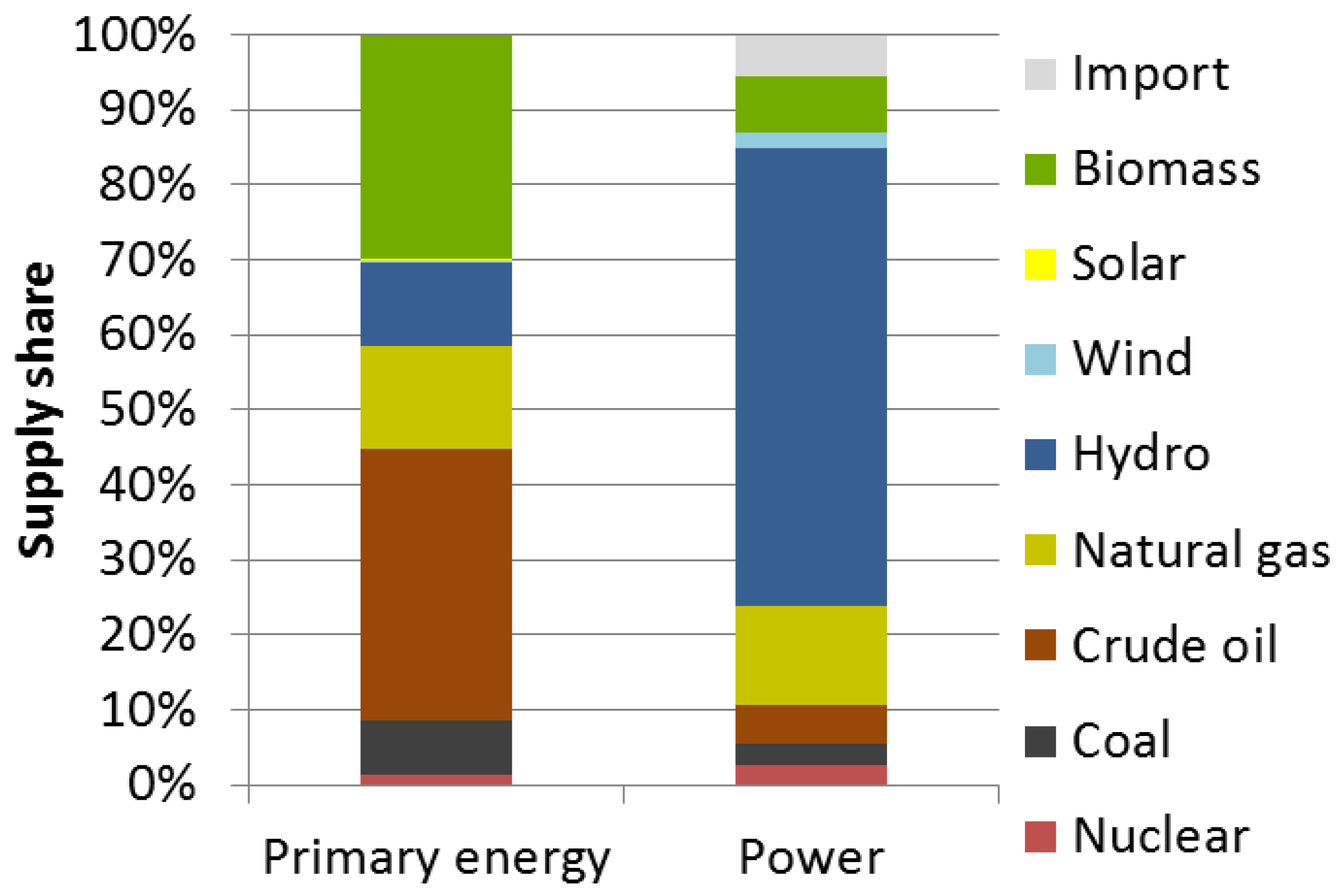
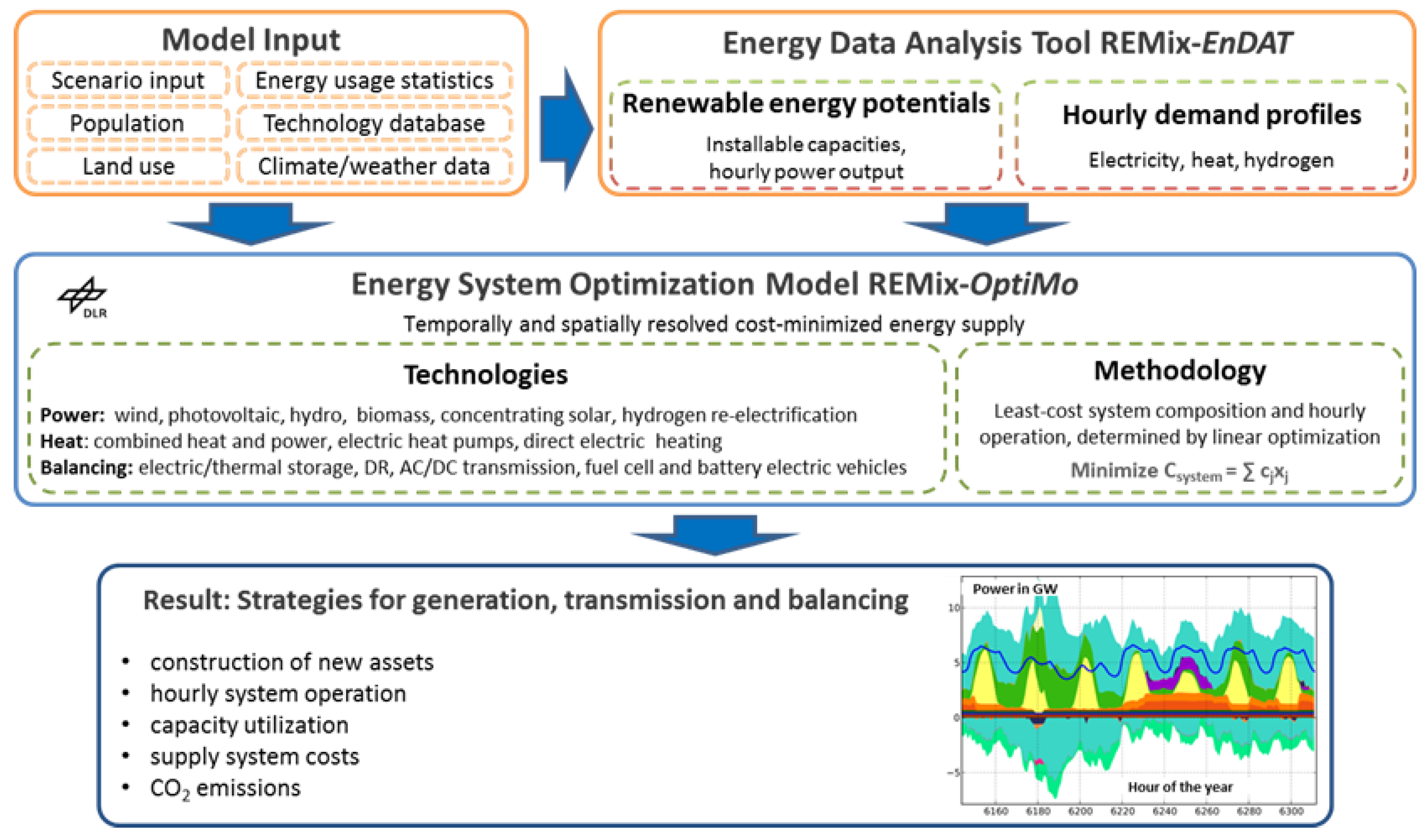
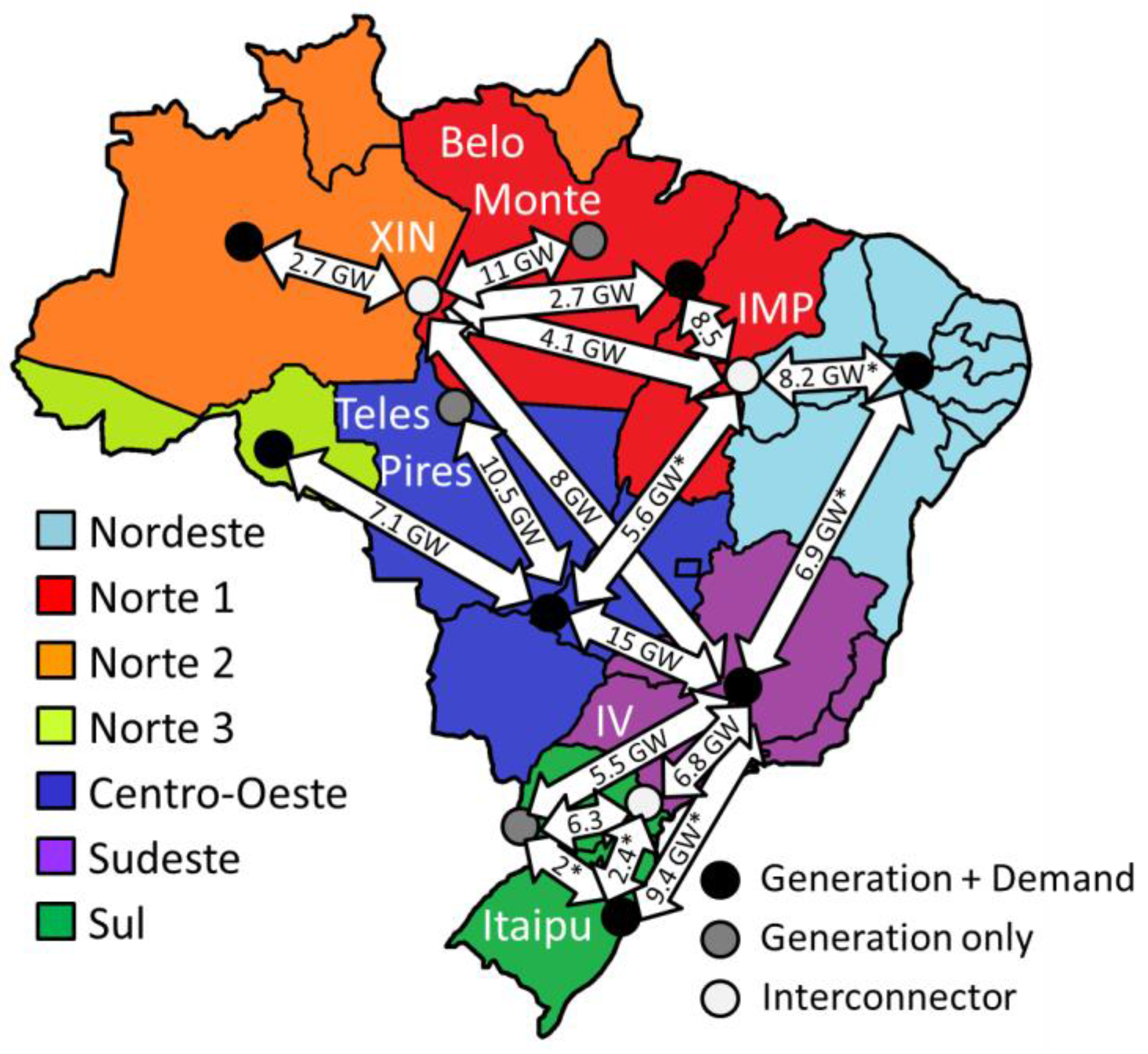
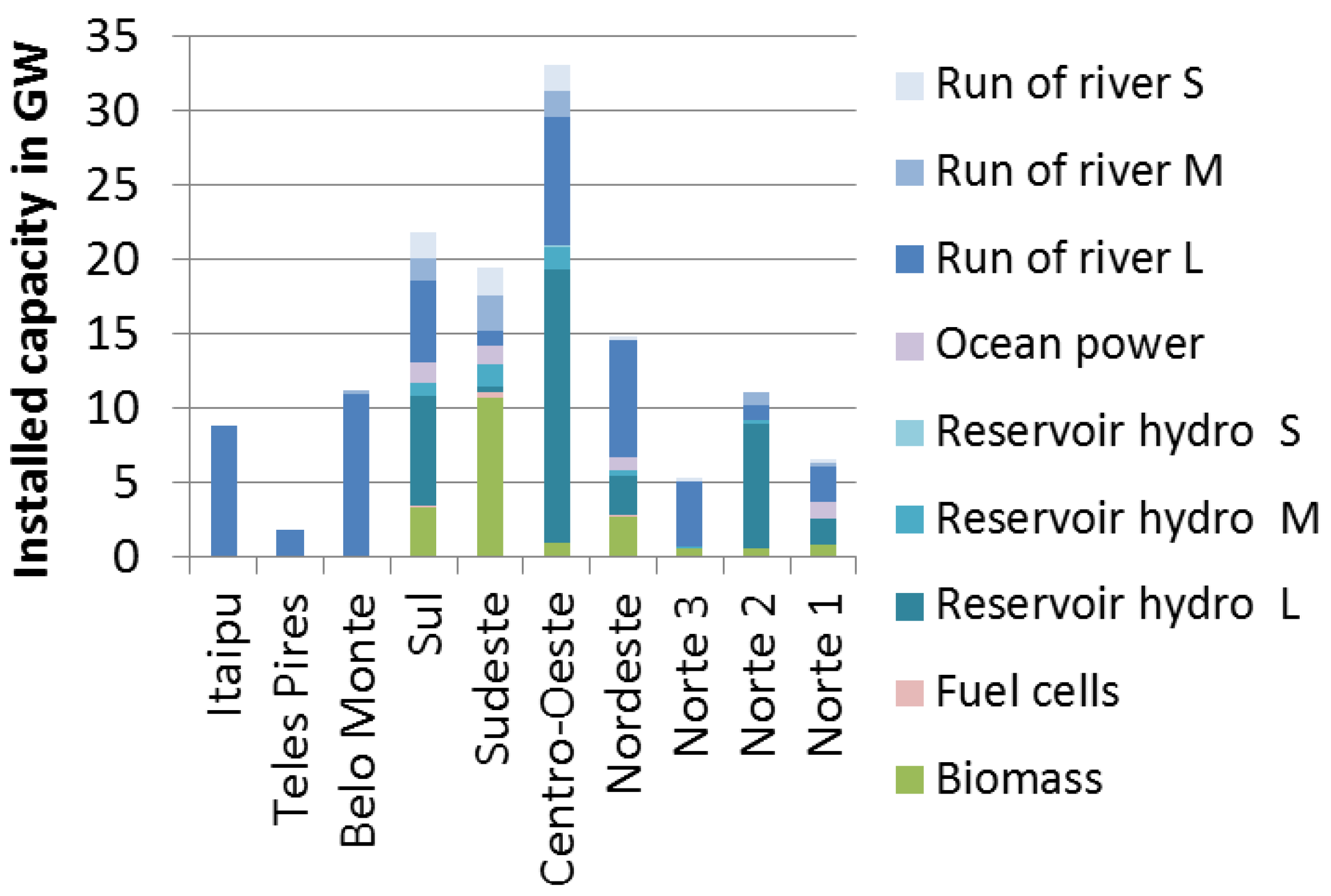
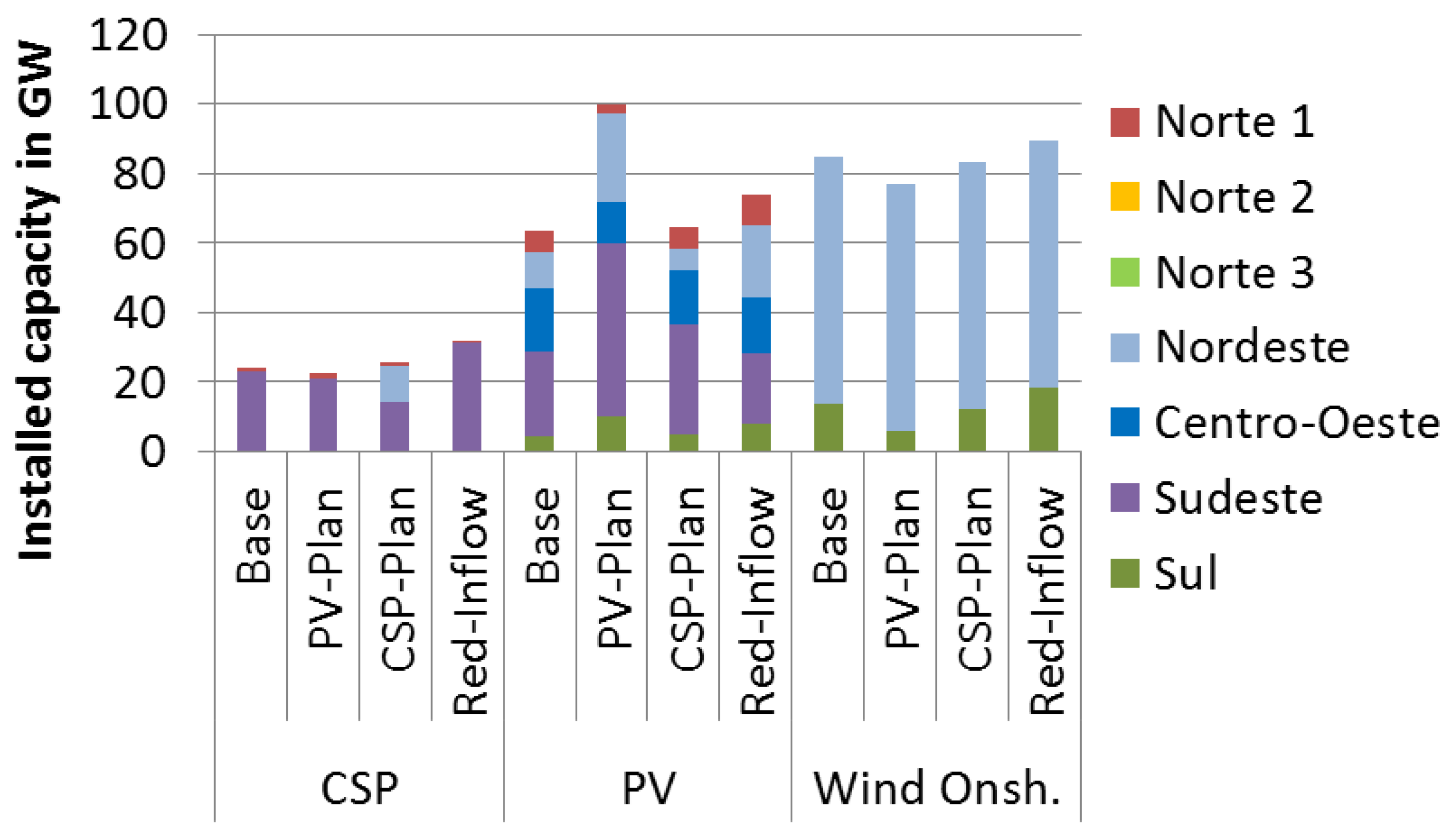
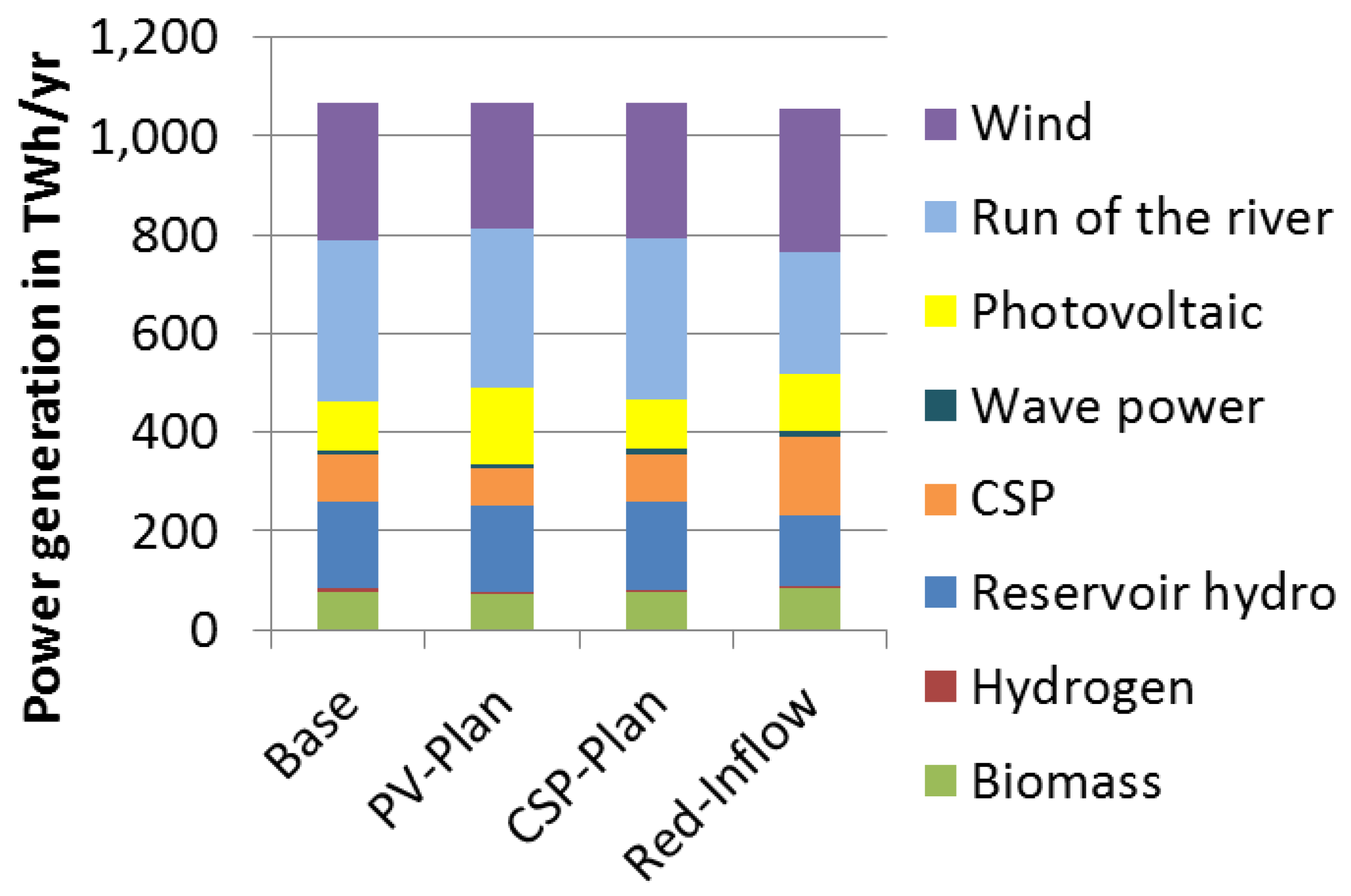
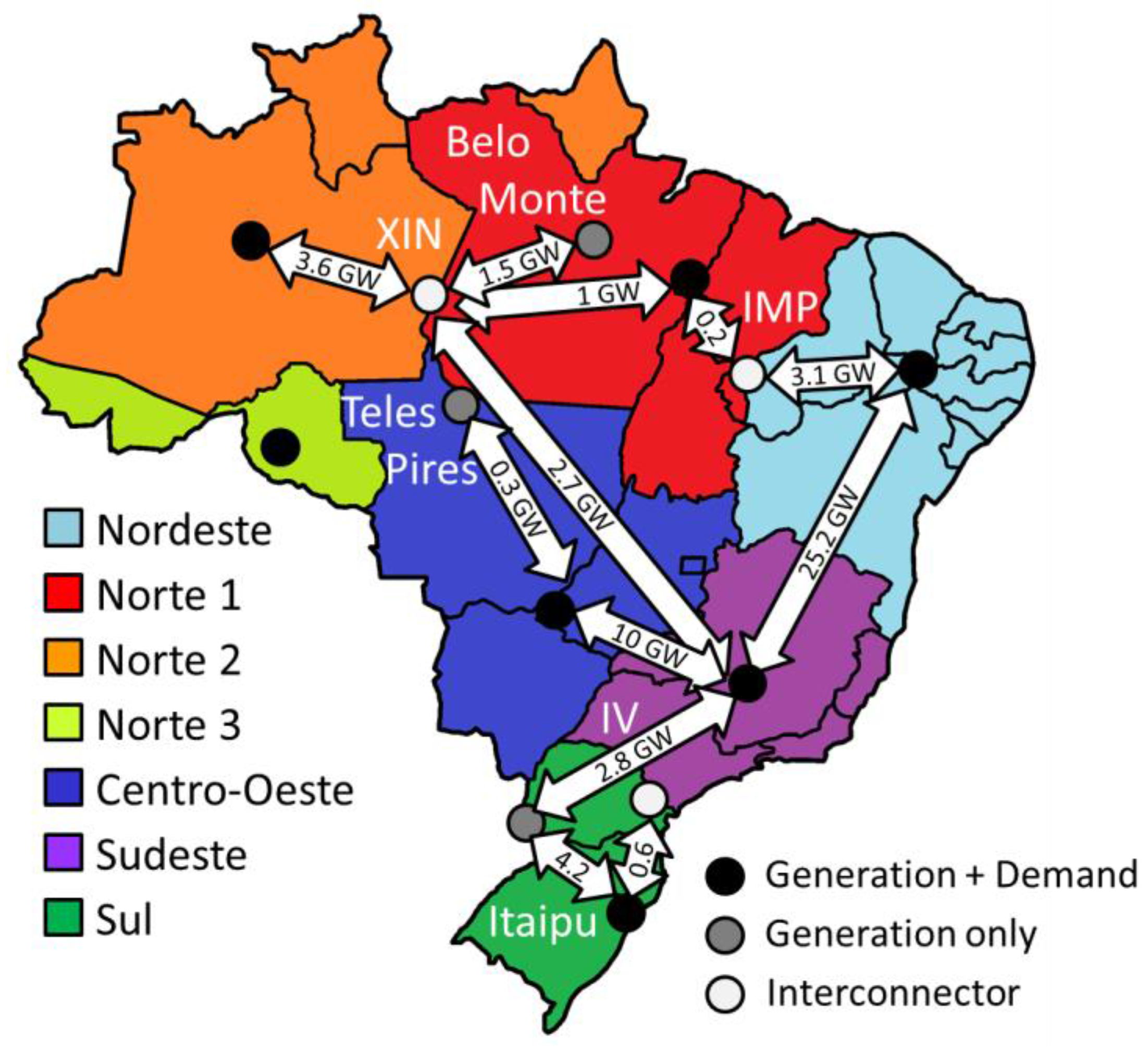
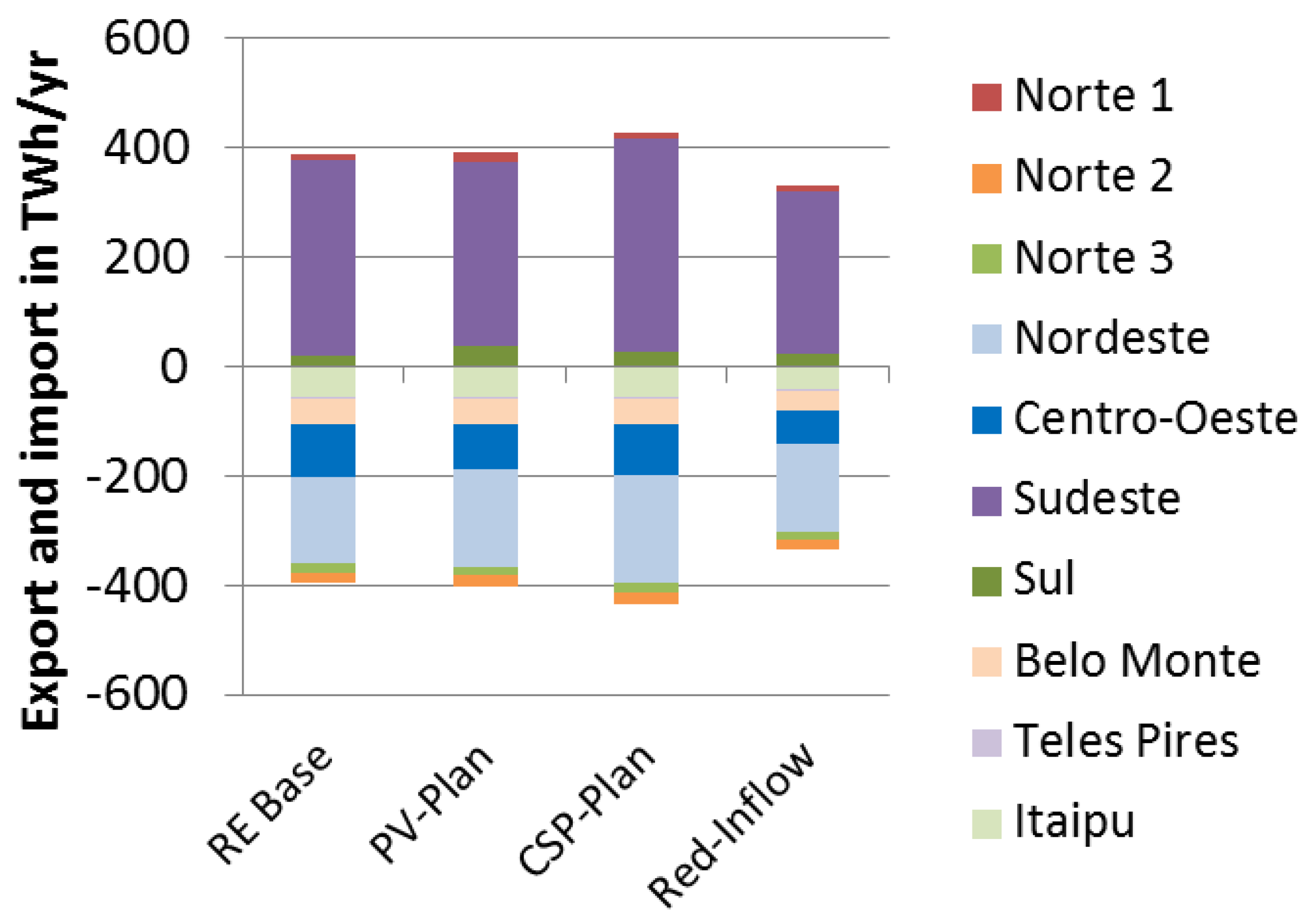
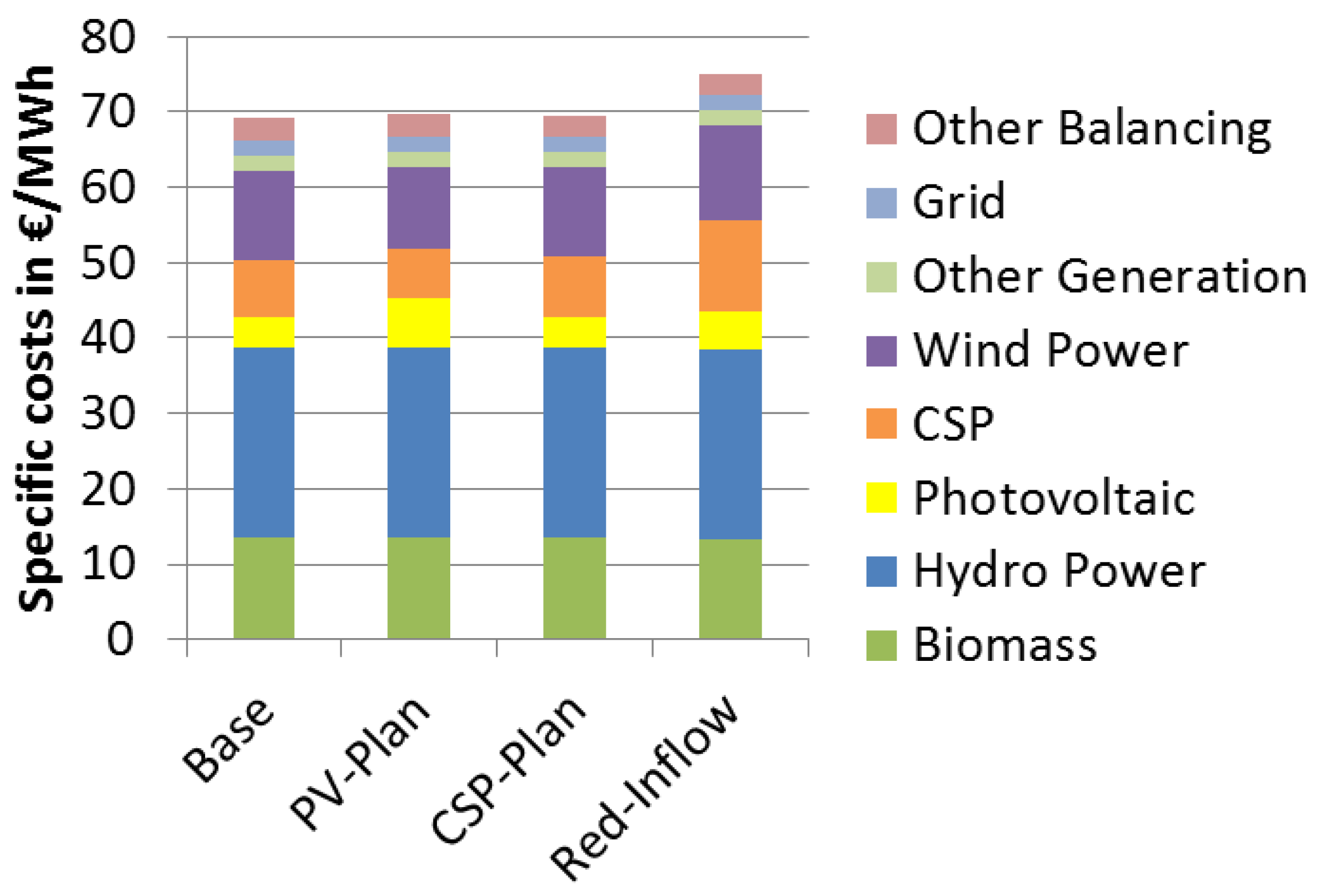
| Use of Technology | Exogenously Defined Capacities | Endogenously Calculated Capacities |
|---|---|---|
| Generation | Run-of-river hydro (existent/under construction) Reservoir hydro (existent/under construction) Biomass CHP Fuel cell CHP Wave power | Run-of-river hydro (investment options) Reservoir hydro (investment options) Photovoltaic Wind onshore Wind offshore CSP Hydrogen gas turbine Hydrogen combined cycle gas turbine |
| Grid | Existing AC and DC lines | Additional AC and DC lines |
| Storage and demand flexibility | Demand response | Battery storage |
| Flexible electric heating | Hydrogen storage | |
| Flexible hydrogen electrolysis | Pumps in reservoir hydro stations |
| Region Name | Wind Offshore | Wind Onshore | Photovoltaic | CSP | ||||
|---|---|---|---|---|---|---|---|---|
| GW (el) | h/Year | GW (el) | h/Year | GW (el) | h/Year | GW (th) | h/Year | |
| Nordeste | 79 | 3922 | 71 | 3384 | >1000 | 1659 | >1000 | 2007 |
| Norte 1 | 16 | 2757 | 253 | 914 | >1000 | 1580 | 5 | 2027 |
| Norte 2 | 13 | 2155 | 26 | 892 | >1000 | 1481 | 0 | 0 |
| Norte 3 | 0 | 0 | 0 | 0 | 313 | 1411 | 0 | 0 |
| Centro-Oeste | 0 | 0 | 44 | 2371 | >1000 | 1546 | 576 | 1997 |
| Sudeste | 16 | 2639 | 48 | 1639 | >1000 | 1568 | >1000 | 1959 |
| Sul | 14 | 3468 | 28 | 2852 | >1000 | 1286 | 0 | 0 |
| Technology | Efficiency | Availability | Specific Investment | Specific Invest. Storage | Amortization Time | Fixed O & M Costs | References | |
|---|---|---|---|---|---|---|---|---|
| % | % of Time | k€/MW | k€/MWh | Years | % of Invest/ | |||
| VRE | Photovoltaic | -- | 95% | 520 | -- | 20 | 1% | [58,59,60] |
| Wind onshore | -- | 92% | 900 | -- | 20 | 4% | [59,60,61] | |
| Wind offshore | -- | 92% | 1800 | -- | 20 | 6% | [59,60,61] | |
| Wave power | -- | 92% | 2000 | -- | 20 | 6% | [60,61] | |
| Dispatchable RE | Hydro S < 30 MW | -- | 91% | 2450 | -- | 40 | 2% | [39,59] |
| Hydro M 30-300 MW | -- | 92% | 2090 | -- | 40 | 3% | [39,59] | |
| Hydro L > 300 MW | -- | 89% | 1730 | -- | 40 | 2% | [39,59] | |
| Single cycle gas turbine | 47% | 95% | 400 | -- | 25 | 4% | [60,61] | |
| Combined cycle gas turbine | 67% | 96% | 700 | -- | 25 | 4% | [60,61] | |
| CSP | 37%/95% 1 | 95% | 970/250/25 2 | -- | 25 | 3% | [61] | |
| Fuel cell | 27%/53% 3 | 98% | 2000 | -- | 20 | 2% | [60,61] | |
| Biomass CHP | 34%/53% 3 | 98% | 1950 | -- | 20 | 2% | [60,61] | |
| Storage | Vanadium redox battery | 81% | 98% | 300 | 100 | 20 | 3% | [62] |
| Hydrogen storage tanks | 96% | 100% | n.a. | 24 | 30 | 2% | [63] | |
| Pumped reservoir hydro | 80% | 90% | 640 | n.a. | 20 | 3% | [61] | |
| PEM Electrolyser | 71% | 100% | 321 | n.a. | 20 | 2% | [63] | |
© 2017 by the authors. Licensee MDPI, Basel, Switzerland. This article is an open access article distributed under the terms and conditions of the Creative Commons Attribution (CC BY) license (http://creativecommons.org/licenses/by/4.0/).
Share and Cite
Gils, H.C.; Simon, S.; Soria, R. 100% Renewable Energy Supply for Brazil—The Role of Sector Coupling and Regional Development. Energies 2017, 10, 1859. https://doi.org/10.3390/en10111859
Gils HC, Simon S, Soria R. 100% Renewable Energy Supply for Brazil—The Role of Sector Coupling and Regional Development. Energies. 2017; 10(11):1859. https://doi.org/10.3390/en10111859
Chicago/Turabian StyleGils, Hans Christian, Sonja Simon, and Rafael Soria. 2017. "100% Renewable Energy Supply for Brazil—The Role of Sector Coupling and Regional Development" Energies 10, no. 11: 1859. https://doi.org/10.3390/en10111859





